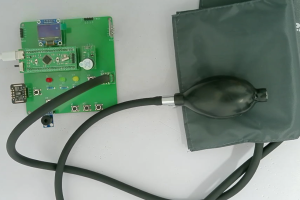设计说明书
总字数:18000+
摘要
在人口老龄化进程不断加快的背景下,社区养老服务的智能化、个性化升级成为提升老年人生活质量与安全保障的关键。传统的社区养老模式往往存在健康监测不及时、求助响应滞后、服务效率偏低等问题,难以满足老年人对便捷化、精准化养老服务的需求。
基于 STM32F103C8T6 单片机的社区自愿互助养老系统,整合了 MAX30102 心率血氧检测模块、MLX90614 非接触红外体温检测模块、XGZP6847 血压检测模块、声光报警装置、红黄绿三色指示灯、6 个独立按键、OLED 显示屏及 ECB02 蓝牙模块,实现了老年人健康状态的实时监测与互助服务的高效响应。系统核心功能包括:通过 MAX30102 模块检测心率和血氧值,经对应按键启动检测后,若数值超出设定阈值则触发声光报警;借助 MLX90614 模块检测体温,按键启动后,体温异常时同步触发声光报警;利用 XGZP6847 模块检测血压,按键启动检测后,血压偏离阈值范围即启动报警;设置红、绿、黄三色指示灯分别对应 “需要帮助”“娱乐消息”“其他事务”,指示灯状态可同步显示在 OLED 屏及手机端;支持通过 3 个独立按键或手机端设置各项健康参数的阈值;通过 OLED 显示屏实时展示心率、血氧、体温、血压等健康数据及指示灯状态;依托 ECB02 蓝牙模块将数据同步至手机端,实现远程监测与阈值设置功能。
该系统的应用,有效提升了社区自愿互助养老服务的智能化水平,通过及时的健康监测与报警机制保障老年人安全,同时借助便捷的信息传递功能优化互助服务效率,为社区养老模式的创新提供了实用参考,具有较强的现实意义。
关键词:STM32F103C8T6;社区养老;互助系统;健康监测;蓝牙通信;声光报警
ABSTRACT
With the accelerating process of population aging, the intelligent and personalized upgrading of community elderly care services has become crucial for improving the quality of life and safety guarantee of the elderly. Traditional community elderly care models often suffer from problems such as delayed health monitoring, slow response to help requests, and low service efficiency, making it difficult to meet the elderly’s demand for convenient and precise elderly care services.
The community voluntary mutual-aid elderly care system based on the STM32F103C8T6 microcontroller integrates MAX30102 heart rate and blood oxygen detection module, MLX90614 non-contact infrared temperature detection module, XGZP6847 blood pressure detection module, sound and light alarm device, red, green and yellow indicator lights, 3 independent buttons, OLED display and ECB02 Bluetooth module, realizing real-time monitoring of the elderly’s health status and efficient response of mutual-aid services. The core functions of the system include: detecting heart rate and blood oxygen levels through the MAX30102 module, and triggering sound and light alarms if the values exceed the set thresholds after the detection is started by the corresponding button; detecting body temperature through the MLX90614 module, and synchronously triggering sound and light alarms when the body temperature is abnormal after the button is pressed to start detection; using the XGZP6847 module to detect blood pressure, and activating the alarm when the blood pressure deviates from the threshold range after the detection is started by the button; setting red, green and yellow indicator lights corresponding to “need help”, “entertainment messages” and “other matters” respectively, and the status of the indicator lights can be synchronously displayed on the OLED screen and the mobile phone; supporting the setting of thresholds for various health parameters through 3 independent buttons or the mobile phone; real-time display of health data such as heart rate, blood oxygen, body temperature, blood pressure and indicator light status through the OLED display; synchronizing data to the mobile phone via the ECB02 Bluetooth module to realize remote monitoring and threshold setting functions.
The application of this system effectively improves the intelligence level of community voluntary mutual-aid elderly care services. It ensures the safety of the elderly through timely health monitoring and alarm mechanisms, and optimizes the efficiency of mutual-aid services through convenient information transmission functions. It provides a practical reference for the innovation of community elderly care models and has strong practical significance.
Keywords: STM32F103C8T6; Community elderly care; Mutual-aid system; Health monitoring; Bluetooth communication; Sound and light alarm
目录
第 1 章 绪论
1.1 研究的目的及意义
1.2 国内外发展情况
1.3 本文主要研究内容
第2章 设计思路与方案论证
2.1 主要元器件选择
2.1.1 主控芯片选择
2.1.2 心率血氧检测模块选择
2.1.3 体温检测模块选择
2.1.4 血压检测模块选择
2.1.5 指示灯选择
2.1.6 按键模块选择
2.1.7 显示模块选择
2.1.8 蓝牙模块选择
2.2整体设计方案
第 3 章 硬件设计
3.1 主控电路模块
3.2 心率血氧检测模块电路
3.3 体温检测模块电路
3.4 血压检测模块电路
3.5 指示灯电路
3.6 显示模块电路
3.7 蓝牙模块电路
3.8 按键模块电路
3.9 声光报警模块电路
第4章 系统程序设计
4.1 编程软件介绍
4.2 系统主流程设计
4.3 独立按键
4.4 OLED显示流程设计
4.5 ADC模数转换子流程设计
4.6 红外测温模块子流程设计
4.7 心率血氧模块子流程设计
第 5 章 实物测试
5.1 整体实物测试
5.2 心率血氧检测模块功能测试
5.3 体温检测模块功能测试
5.4 血压检测模块功能测试
5.5 蓝牙模块功能测试
5.6 指示灯功能测试
5.7 声光报警模块功能测试
5.8 按键设置与显示功能测试
第 6 章 总结与展望
6.1 总结
6.2 展望
致谢
参考文献
附录
附录一:原理图
附录二:PCB
附录三:主程序
购买后可查看具体内容!

